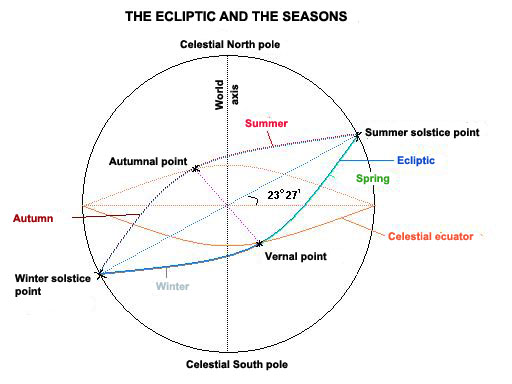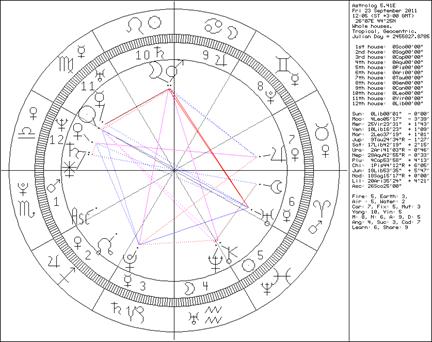On Solstices and Equinoxes
by astrologer Rodica Purniche
It is hard to say precisely when the “beginning” of this topic can be set in the history of the human culture and civilization. We can assume, however, that absolutely all the great civilizations of the ancient world that knew a special development of science and spirituality were focused on the permanent observation of the sky, and the fact that where astronomy flourished, also astrology developed.
Dr. S. Madhavan, scientist, astrologer and astrology researcher, in his book, Muddle of Ayanamsa (Controversies around Ayanamsa), aiming to bring in the concept of precession of the equinoxes as clear as possible, makes a very necessary and interesting history of the interest which, over centuries, these important celestial points raised to astronomers and astrologers.
Solstices and equinoxes are, astronomically speaking, places where the Sun’s apparent race, called the ecliptic, crosses or distances to the maximum from the celestial equator. This occurs because the ecliptic is tilted by 23°27′ to the plane of the equator, which makes the sun:
– cross the celestial equator on 21st – 23rd of March, respectively on 21st – 23rd of September
– have maximum distance above the celestial equator on the 21st – 23rd of June
– have the maximum distance below the celestial equator on the 21st – 23rd of December.
The points where the ecliptic crosses the celestial equator in March and September are called equinoxes and represent the vernal point or the first degree of Aries, and respectively, the autumnal point or the first degree of Libra. These are the vernal equinox and, respectively, the autumn equinox. Their common feature is that the day is equal in duration with the night.

The vernal equinox is the point where the Sun passes from the south latitude to the north latitude of the celestial sphere, while the autumnal equinox is the point at which the Sun passes from north latitude to the south latitude of the celestial sphere.
From the vernal equinox the Sun rises on the ecliptic till it reaches its highest point at the summer solstice, when we have the longest day of the year. Once the northernmost point of its apparent motion is reached, the Sun begins to descend on the ecliptic reaching its most southern point at the winter solstice, when we have the longest night of the year.
Solstices and equinoxes mark the seasons and the astronomical beginning of the seasons, and because of them, calendars appeared subsequently. Solstices and equinoxes are also the base of the tropical year, meaning the astronomical year that takes into account the Sun’s motion through the zodiacal belt (the zodiac of the 12 astrological signs), from the zodiac sign of the Aries to the zodiac sign of the Pisces. Babylonians, Egyptians, Greeks and Indians have studied the apparent motion of the Sun on the ecliptic and they discovered the phenomenon of precession of the equinoxes which we will discuss in another article.
Hipparchus was the first to submit the four important moments of the Sun’s motion to attention, thus discovering the phenomenon of precession and defining the tropical year and the sidereal year and also their duration for the first time with a very high accuracy. Hundreds of years later, Copernicus, Ticho Brache, Galileo Galilei, Newton and many others deepened the phenomenon of precession of the equinoxes and also the tropical-sidereal opposition in astronomy and astrology.
The Indian astronomers went in parallel with the Europeans’ observations. Suryasiddhantha is an impressive treatise on astronomy which equals in value the 4 Vedas, and in which the solstices, equinoxes and also the phenomenon of precession, called ayanachalana in Sanskrit are mentioned. Aryabhata I and Suradevayajvan appreciated the period when the tropical and sidereal Zodiac coincided. Varahamihira continued this topic later. Munjala, in his work, Laghumanasa, explained the phenomenon of precession and indicated its rate and Bhaskara II theory developed the theory of the complete revolution of the equinoxes.
At the end of so many centuries of dispute and astronomical research, exceptionally summarized in the work mentioned at the beginning of this article, Prof. Dr. S. Madhavan concludes: “It seems that the sidereal system (nirayana) was used in astrology with predictive purposes, whereas the tropical system (sayana) was used in astronomy to observe the equinoxes and solstices.”
Since any astronomical reality has an astrological “reflection” and also a spiritual significance, solstices and equinoxes are known in the Vedic astrology (Jyotish) under the name of Gandanta. Gandanta is a word of Sanskrit origin, coming from Gand – “knot” and anta – “end”. It means “karmic knot” or “spiritual knot”. Gandanta represents, in a native theme, the junction points where the monthly and the solar zodiac meet, these points being directly associated with the moments of inner growth or spiritual leap.
Gandanta points are at the passing point between:
– Pisces (Revati Nakshatra) and Aries (Ashwini Nakshatra)
- Cancer (Nakshatra Aslesha) and Leo (Nakshatra Hungarian)
– Scorpio (Mula Nakshatra) and Sagittarius (Nakshatra Jyeshtha).
The Moon or the Ascendant positioned at the moment of birth in an orb 00°48′ to these points is a Gandanta, a “spiritual knot” which, at some point in life, has to be “cut” (meaning that the native will have a major spiritual test completed either with a real spiritual leap or with a spiritual failure).
Although the Gandanta points are not at all solstices and equinoxes, they are energetically identical to them and can be considered similar.
The solstices and the equinoxes represent the entrance of the Sun in the space corresponding to the cardinal signs which, in their turn, correspond to the cardinal points (Cancer – North, Aries – East, Capricorn – South, Libra – West). Cardinal zodiac signs have the Fire Element nature, their energy being able to generate, to direct, to lead.
The Gandanta points represent the crossing of the Sun from one type of fire to another:
- the nature of the Fire Element corresponding to the Aries constellation is a sacrificial nature, heroic, opening new paths, leading in a spontaneous way
– the nature of the Fire Element corresponding to the Leo constellation is royal, generous , protective, all-covering, leading in a conscious way
- the nature of the Fire Element corresponding to the Sagittarius constellation is a guiding nature, idealistic, spiritual, leading in a higher, spiritual, divine way.
The successive transits of the Sun, symbol of the Divine Self Atman in the Vedic astrology, through these zodiac areas and through any of these 7 (4 +3) points of hiatus, signify the stages of evolution of the human being which, at the moments of solstices and equinoxes, is permanently “infused” with sublime, elevated, divine energy, in order to expedite its completion.
A profoundly Venusian autumn equinox
– 23.09.2011, 12h05 (+3h00GMT), 26E06/44N24 –

The autumn Equinox occurs at 12:05 (+3h00GMT) local time, important astral moment when the sun enters the zodiac sign of the Libra. It is a moment of balance between opposing polar forces of Yin and Yang, when the resonance with the macrocosmic energies of Harmony, Beauty and Divine Love starts to amplify. The most important lessons during the solar transit through this sign will be those of complementarity and cooperation, of the goodwill and concessions, of moderation and prudence in action, the elevation and our refinery through culture and art. Well learned, these lessons can ultimately become the “fuel” for real and final spiritual leaps.
It is a very special autumn equinox because it takes place at midday, moment that balances the midnight, so when the Light is at its peak and overcomes for good the forces of the darkness, this balance enhancing the energy of equality between the duration of day and the night.
Also, the equinox is very special because it occurs in a Friday, a day ruled by Venus, the governor, in fact, of the zodiac sign of the Libra. Moreover, at this time, Venus is located in its daytime solar home, of yang energetic polarity, namely the zodiac sign of the Libra. In other words, we are part of a deeply Venusian autumn equinox, in which the resonance with the sphere of the Great Cosmic Power Tripura Sundari reaches its peak, enhancing the artistic sensitivity, aesthetic maturity, creative manifestation, divinely inspired creativity, good taste and the communion with the universal emotional plane.
Another spiritual feature of the moment of the autumn equinox is the presence of the planets considered “masculine” (Sun and Mars) and “feminine” (Moon and Venus) in the zodiac signs of yang energetic polarity, i.e. Sun / Venus in the zodiac sign of the Libra and Moon / Mars in the zodiac sign of the Leo. In other words, the pairs of planets in these signs emit towards the terrestrial plan and support, both in the human being and in each human couple, the state of solarity, self-control, dignity and determination, refinement in relationship – all infused by the specific aspects of Venus in the Libra zodiac sign.
Finally, another special relationship is the one between Mercury, located in the zodiac sign of the Virgo, its nocturnal domicile, of yin energetic polarity, and Venus, located in the zodiac sign of the Libra, its diurnal home, of yang energetic polarity. It is an ideal balance between mind and heart, between the mental and emotional plan, between the mental and emotional discernment, between the state of lucidity and the state of affection without object.
Because Venus has covered only a third of its diurnal Sign, all these qualities discussed here will experience a gradual increase as the planet moves in the Sign, and between October 4 to 9, when it will go past the last 5 degrees of the zodiac, those qualities will reach their maximum and we will already reap the fruits of the behavioral features mentioned above.
It is best therefore to start during these days – whose spiritual value will be enhanced by the Shiva Ratri moment (Sunday, September 25) – healing treatments and purification techniques, long-term practices and spiritual techniques, writing or development of pieces of art or the realization of our creative abilities. The relationships that start, or are re-launched or enforced in this Venusian interval will capture, assimilate and express the environment in which they manifest harmony, charisma, power of transformation, energizing of the ambient and beauty.
yogaesoteric
17 November 2011
Also available in:
 Română
Română
